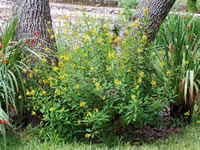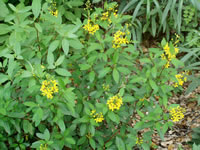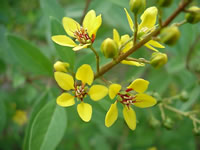|
Galphimia glauca -- Thryallis
This compact upright rounded, evergreen shrub is covered during
most of the year with small. very showy, yellow flowers. The loose,
open natural growth habit is ideal for informal plantings but
it will
need some pruning to keep from being too leggy. It can be sheared
into
a more formal hedge and can he used for topicary. but some flowers
will be trimmed of at each pruning. Sheared plants often thin
out at the bottom. To help prevent this, keep the bottom of a
hedge slightly wider than the top to allow sunlight to reach the
lower foliage.
Scientific name: Galphimia glauca
Pronunciation: gal-FlM-ee-uh GLOCK-uh
Common name(s): Thryallis, Rain-of-Gold
Family: Malpighiaceae
Plant type: shrub
USDA hardiness zones: 9B through 11
Planting month for zone 9: year round
Planting month for zone 10 and 11: year round
Origin: not native to North America
Uses: border: mass planting: specimen: container or above-ground
planter Invasive potential: not known to he invasive Pest resistance:
no serious pests are normally seen on the plant
Use and Management
Full sun is needed for best apperrance and flowering but Thryallis
can tolerate some shade. Flowering may be sparser without a full
day of sun. Plant three to five feet apart in shrub border or
in any mass planting. Plants are killed to the ground at about
25-degrees F. but quickly regrow in the spring in USDA hardiness
Zones 8b and 9.
Thryallis is propagated by seeds, sown while still green, or by
tender softwood cuttings in summer. Seedlings will bloom when
one-foot-tall and six-months-old.
Thryallis is pest-free, only occasionally being bothered by caterpillars
and mites. DEER WILL NOT EAT THRYALLIS.
============================================
Description
Height: 5 to 9 feet
Spread: 4 to 6 feet
Plant habit: oval
Plant density: dense
Growth rate: moderate
Texture: fine
Foliage
Leaf arrangement: opposite/subopposite
Leaf type: simple
Leaf margin: entire
Leaf shape: oblong
leaf venation: pinnate
Leaf type and persistence: evergreen
Leaf blade length: 2 to 4 inches
Leaf color: green
Fall color: no fall color change
Fall characteristic: not showy
Flower
Flower color: yellow
Flower characteristic. Year-round flowering
Fruit
Fruit shape: oval
Fruit length: less than .5 inch
Fruit cover: dry or hard
Fruit color: green
Fruit characteristic: inconspicuous and not showy
Trunk and Branches
Trunk/bark/branches: not particularly showy; typically multi-trunked
or clumping stems
Current year stem/twig color: reddish
Current year stem/twig thickness: thin
Culture
Light requirement: plant grows in full sun
Soil tolerances: slightly alkaline; clay; sand; acidic; loam
Drought tolerance: moderate
Soil salt tolerances: poor
Plant spacing: 36 to 60 inches
Other
Roots: usually not a problem
Winter interest: plant has winter interest due to unusual
form, nice persistent fruits, showy winter
trunk, or winter flowers
Outstanding plant: not particularly outstanding
===================================================
Written by Professor Edward F. Gilman, Environmental Horticulture
Department, Cooperative Extension Service, Institute of Food and
Agricultural Sciences, University of Florida, Gainesville, 32611
in October, 1999
|







